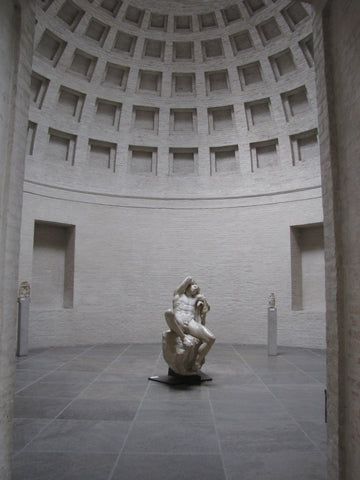Sun, Statues, and Samnites – A Trip to Munich’s Museums
Just before becoming the Editor for Ancient History Magazine, I was on holiday in Munich. During my trip I visited Berchtesgaden in the Alps, Salzburg just across the Austrian border, and Nymphenburg Palace in Munich, but the ancient historian in me loved Munich’s museums the most.
Sitting across Königsplatz from one another, just one stop along the U-Bahn from Munich’s Central Station, stand the Staatliche Antikensammlung and the Glyptothek. Both are renowned museums on Ancient Greece and Rome, and on Sundays, entry to these museums is only €1.00!
My first stop, offering a much-welcome respite from the 35-degree heat, was the Staatliche Antikensammlung. This museum has a much varied collection, with a wide array of Archaic Black- and Red-Figure pottery, including the well-recognisable Dionysus Cup by Exekias, intricate pieces of jewellery and glass-work, and well-preserved finds of ancient Greek arms and armour (unfortunately, the Etruscan exhibition was closed when I was there).
In addition to their permanent collection, while I was visiting, the museum also had a special exhibition on display, ‘Samnium and the Samnites’. This exhibit was by far my favourite, including Samnite pottery, arms and armour (including a reconstructed Samnite warrior’s panoply), and two Samnite inscriptions. To me, these inscriptions were eye-opening, and the most important part of the exhibit.

More often than not, non-Roman Italic peoples, save the Etruscans, are discussed only insofar as they relate to the Romans. In the case of the Samnites, they are largely relegated to discussions on the development of the Roman manipular system or the Social War, and they are often portrayed as a tribal people living in the hills to which the Romans brought civilisation (at least, in my admittedly limited experience). When I saw these inscriptions, as intricate as anything produced by the Greeks or Romans, I knew what I thought of the Samnites was completely wrong. I will certainly be reading more about this ancient people (and who knows, perhaps we’ll have a future volume on them!).
Leaving the Staatliche Antikensammlung, crossing Königsplatz, the Glyptothek was next. While the former museum has a more varied collection than the Glyptothek, the latter holds a wealth of statues dating from the Archaic Greek period to the Late Antique Roman period, complementing one another well, and should certainly be visited together.
Just as the Staatliche Antikensammlung’s collection includes world-famous artefacts, so too does the Glyptothek’s collection, with statues such as the rigid Kouros of Tenea or the languid Barberini Faun.

Wandering the corridors of the museum you feel like you are gazing upon some of the greatest works of antiquity, and the guides provide a great deal of information on each piece. Of all these statues, my personal favourite was the sculpture groups that composed the pediments of the Temple of Athena Aphaia.
The two pediments represent scenes from the Trojan Wars, with the eastern pediment depicting Heracles’ sacking of Troy and the western pediment depicting the war of the Iliad. What is fascinating about these pediments, to me, is that they demonstrate how our understanding of the hierarchy of Greek mythological figures, with Heracles occupying a preeminent position, might not be what the Greeks themselves always thought. On these pediments, Heracles is a character of secondary importance, with emphasis placed instead on Telamon and Peleus, who flank Athena on the eastern pediment, and their sons Ajax and Achilles occupying the same places on the western pediment. To those familiar with Greek mythology, this orientation of the statues makes some sense, as both Telamon and Peleus are Aeacidae, sons of Aeacus, a king of Aegina, but for them to take precedence over Heracles is incredible to modern audiences.

Neither the Staatliche Antikensammlung nor the Glyptothek are large museums, but they are filled with fascinating pieces of ancient art history. I would have happily spent my entire Sunday, from dawn to dusk, wandering about the exhibits.
If you’re ever in Munich, I definitely recommend taking some time to visit, you shan’t be disappointed.


1 comment
I’ll visit when I can. Hopefully combining a kayak trip to the ice canal in Augsburg.